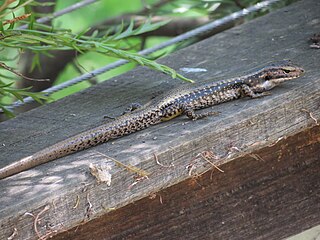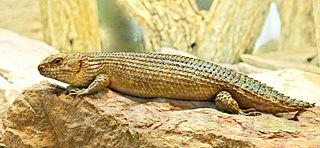
Skinks are lizards belonging to the family Scincidae, a family in the infraorder Scincomorpha. With more than 1,500 described species across 100 different taxonomic genera, the family Scincidae is one of the most diverse families of lizards. Skinks are characterized by their smaller legs in comparison to typical lizards and are mostly found in different habitats except arctic and subarctic regions.

Eulamprus is a genus of lizards, commonly known as water skinks, in the subfamily Lygosominae of the family Scincidae. The genus is native to Australia.

The prickly skink, or prickly forest skink, is a morphologically and genetically distinctive species of skink endemic to rainforests of the Wet Tropics of Queensland World Heritage Area, in north-eastern Australia. Unlike most small skinks, which have smooth scales, this species has rough, ridged and pointed scales. These keeled scales may be an adaptation to its high-rainfall habitat, to its microhabitat in rotting logs, or to camouflage it when moving through forest leaf-litter.

The Tiliqua scincoides scincoides, or eastern blue-tongued lizard, is native to Australia. It is unique due to its blue tongue, which can be used to warn off predators. In addition to flashing its blue tongue, the skink hisses and puffs up its chest to assert dominance and appear bigger when in the presence of its predators such as large snakes and birds. The eastern blue tongue is ovoviviparous and precocial, meaning that its young are more developed and advanced at their time of birth. The Tiliqua scincoides scincoides is not poisonous to humans and can be found in suburban and urban areas, specifically in house gardens.

The Blue Mountains water skink or Blue Mountains swamp-skink is a species of skink in the family Scincidae. An endangered species, it is found only in restricted parts of the mountains of southeastern Australia.
Allan's lerista, also known commonly as Allan's skink and the greater robust fine-lined slider, is a species of skink, a lizard in the family Scincidae. This rare species is endemic to Queensland, Australia.

White's skink, also known commonly as White's rock skink, is a species of lizard in the family Scincidae. The species is endemic to Australia.

The southern water skink, cool-temperate water-skink, highland water skink, or Dreeite water skink is a medium-sized species of skink that is endemic to Australia. These skinks are found in New South Wales, South Australia, Victoria as well as on Tasmania's Rodondo Island in the Bass Strait. They are viviparous, mating in spring, and giving birth to live young in mid to late summer.

Eulamprus quoyii, more commonly known as the eastern water skink, eastern water-skink, or golden water skink, is a viviparous species of diurnal skink. Eulamprus quoyii belongs to the family Scincidae and is considered a common garden animal in Australia. The skink is endemic to Australia and found only along the east coast of the country. It makes its home in creekside habitats along the east coast of Australia and in urban garden areas with high amounts of moisture. The species can be identified by the twin, long yellow stripes that run along its body from the top of the eye, as well as by several more specific character derived states. The pale yellow dorsolateral stripes are most likely where its common name, the golden water skink, is derived. Like other ectotherms, the skink can often be seen basking in the sun on rocky outcroppings in order to regulate its body temperature. Its diet mainly consists of both aquatic and terrestrial insects, tadpoles and small amounts of plant matter. The skink both hunts for food and scavenges when necessary and is considered an opportunistic feeder. It is prey to larger lizards, snakes, cats and birds and so will often be seen moving quickly into hiding when other organisms are present.

Brachymeles bonitae, commonly known as the stub-limbed burrowing skink or pretty short-legged skink, is a species of skink found in the Philippines. It was first described in 1839 by André Marie Constant Duméril and Gabriel Bibron. It is endemic to the Philippines.
Concinnia is a genus of skinks in the subfamily Lygosominae.
The Quinkan ctenotus is a species of Australian skink, a lizard in the family Scincidae.

Silvascincus is a genus of skinks, lizards in the family Scincidae. Both species in the genus are endemic to Australia. They were previously placed in the genus Eulamprus.

Egernia stokesii is a gregarious species of lizard of the Scincidae family. This diurnal species is endemic to Australia, and is also known as the Gidgee skink, spiny-tailed skink, Stokes's skink and Stokes's egernia. The species forms stable, long-term social aggregations, much like the social groups seen in mammalian and avian species. This characteristic is rarely found in the Squamata order, but is widespread within the Australian subfamily of Egerniinae skinks. Populations of E. stokesii are widely distributed, but fragmented, and occur in semi-arid environments. There are three recognised subspecies. The conservation status for the species is listed as least concern, however, one subspecies is listed as endangered.
Ctenotus zebrilla, also known commonly as the Southern Cape York fine-snout ctenotus, is a species of skink, a lizard in the family Scincidae. The species is endemic to Australia.

The desert egernia or unadorned desert-skink, desert skink, is a species of skink, a lizard in the family Scincidae. The desert egernia is endemic to the continent of Australia, and is widespread, with populations recorded in all mainland states and territories except the Australian Capital Territory. The desert egernia is found in dry, desert areas with deep, uncompacted sandy/loamy soils and little significant vegetation cover.
Carlia isotriacantha, the Monsoonal three-keeled rainbow-skink, is a species of skink. It is endemic to Australia; most records are from the Kimberley region in Western Australia, but there are also some records from the border area between the Northern Territory and Queensland. It measures 25–49 mm (1.0–1.9 in) in snout–vent length.

The blue-speckled forest-skink is a species of skink found in Queensland and New South Wales in Australia.
Sphenomorphus bignelli is a species of skink, a lizard in the family Scincidae. The species is endemic to the Solomon Islands.













